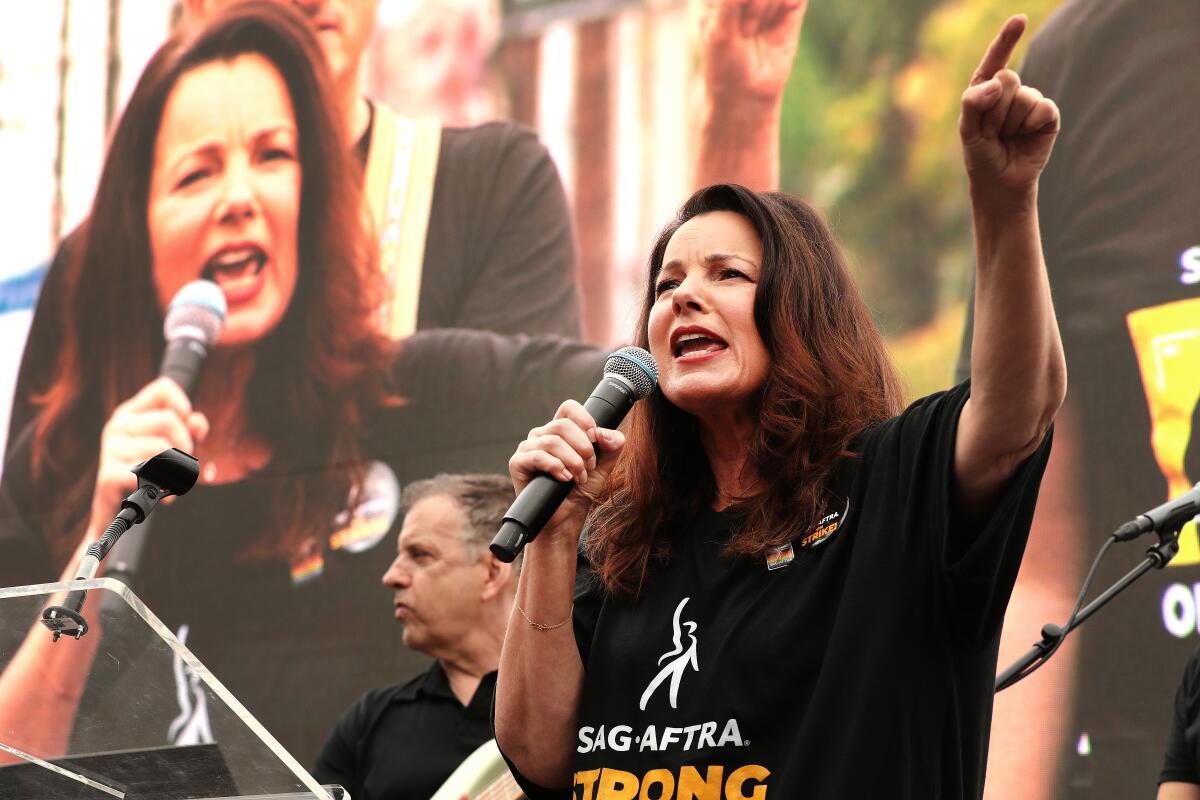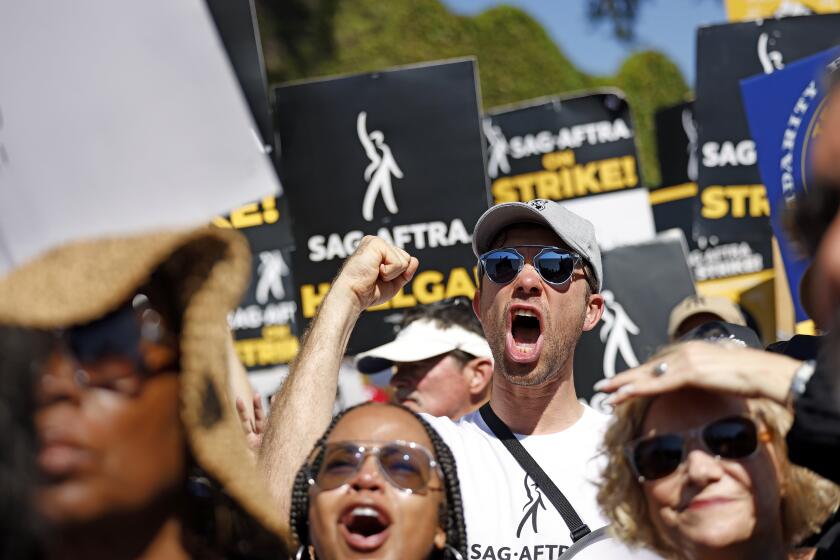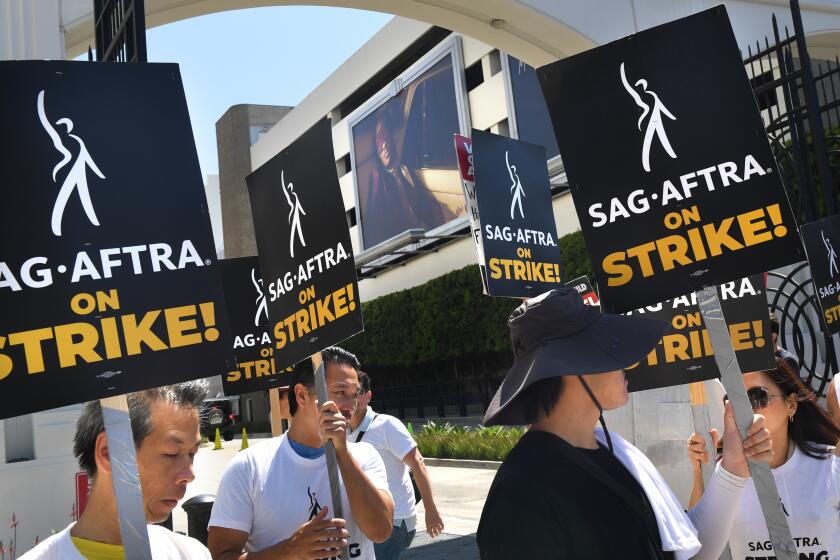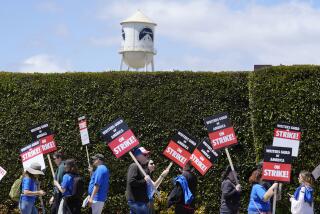Column: The Hollywood strikes are finally over. But we won’t repair the damage anytime soon

- Share via
The Hollywood strikes may be over, but in many ways the pain has just begun.
For reasons of their own — Greed? Stupidity? Master of the Universe arrogance? — the studios, represented by the Alliance of Motion Picture and Television Producers, decided this spring that it was perfectly acceptable to force the entertainment industry, the state of California and the entire country to suffer through a combined 191-day work stoppage before they would offer contracts acceptable to the Writers Guild of America and the Screen Actors Guild-American Federation of Television and Radio Artists, whose negotiating committee on Wednesday approved a tentative deal that would finally end the actors’ walkout.
For six months, the AMPTP repeatedly offered deals that it knew did not address well-documented industry trends and clearly stated union concerns, and when those deals were not accepted, the “negotiators” walked away and watched their own salaries accrue while the strikers took side gigs and watched their savings vanish.
Now, with Christmas music on the radio and Thanksgiving turkeys in grocery stores, the studios have finally offered the deals they should have offered months ago. And the rest of us are left to reckon with the damage.

Subscribers get exclusive access to this story
We’re offering L.A. Times subscribers special access to our best journalism. Thank you for your support.
Explore more Subscriber Exclusive content.
The true economic impact won’t be known for some time, but early estimates as to what the combined strikes have cost the California economy hover at more than $6 billion.
Six. Billion. Dollars. While Netflix Chief Executive Ted Sarandos, who pulled in $50 million last year, wittered on about how SAG’s demand for residuals boiled down to a “levy” on subscribers. While Disney CEO Bob Iger expressed his disappointment over the unions’ failure to understand the difficult position the studios were in — even as his company stood poised to pay Comcast at least $8.6 billion for its stake in Hulu.
While more than 100,000 actors and writers languished unemployed for months, with all of the financial fallout for individuals, families and communities that implies.
Even more important, economically speaking, was all the other work stopped by the strikes.
If approved by union members, the tentative contract would end a strike that lasted nearly four months and shut down Hollywood film and TV productions.
On most movie or TV sets, writers and actors are in the minority, invariably outnumbered by an enormous production team including, but not limited to, directors, the camera department, the art department, lighting and grip, sound, wardrobe, film editors, hair and makeup, stunts and visual effects, craft services, drivers, special effects, security, a gazillion production assistants and, if children and/or animals are involved, tutors and trainers.
Add to that publicists, costume and prop houses and all the local businesses that cater to people working on sets and in writers’ rooms. And every stylist, florist, hotelier, restaurant owner and limo driver who earns money during industry-centered events like film premieres, festivals and galas.
All of whom experienced financial loss and mental anguish during the strikes. None of which will be miraculously corrected the moment production resumes. It will take longer than the strikes lasted for many people so long out of work to regain personal financial stability.
As for the psychological effects, those may be incalculable. How many talented people did the entertainment industry lose when the studios seemed to go out of their way to make it clear that writers and actors — and, by extension, everyone else who makes film and television — were not worth the trouble of coming up with a fair deal in time to avoid the strikes? Then extending the agony again and again before finally offering acceptable contracts?
Many writers I’ve spoken to describe feeling shell-shocked, six weeks after the WGA and the AMPTP first reached a tentative agreement. Though they’re happy to be writing again (even happier now that returning actors will make production possible), some have lost their series, or their deals, and all seem unsure of what the studios want in the already contracting landscape. Longer seasons with more traditional templates? Cost-cutting measures like fewer locations and big-name stars? More emphasis on drawing a big audience than potential awards nominations?
As for the audience, the impact of the dual strikes is just beginning to be felt. Some of us missed seeing red-carpet appearances and interviews with the stars of “A Haunting in Venice,” “She Came to Me,” “Killers of the Flower Moon” or “Exorcist: Believer,” and many of those films suffered at the box office because of it. And I cannot be the only one who was looking forward to “Dune: Part II,” “Challengers” and “Ghostbusters: After Life,” pushed from this fall to 2024.
Sign up for This Evening's Big Stories
Catch up on the day with the 7 biggest L.A. Times stories in your inbox every weekday evening.
You may occasionally receive promotional content from the Los Angeles Times.
But the cascading consequences of the strikes will continue for the foreseeable future. Films that were scheduled for 2024 now won’t appear until 2025, including the next “Avatar” sequel. On TV, we’ll have to wait a year for all of HBO and Max’s most popular shows, including “Hacks,” “The White Lotus,” “The Last of Us” and “House of the Dragon,” while Netflix’s “Stranger Things” must cope not only with the added delay but also with the impact that time will have on its young cast and, by extension, the narrative.
And that’s just what’s onscreen. Streaming itself has become an increasingly unattractive proposition for consumers, with platforms raising prices and introducing ad-supported tiers even before the actors’ strike ended. The once-maligned cable bundle now appears to be a bargain.
Even when actually addressing a long-gestating problem, the studios made things worse. For years, executives stubbornly refused to acknowledge what everyone and her sister was telling them — that there were increasingly too many series on too many platforms. Apparently unable to figure out how to fix the problem on their own, they instead forced two strikes to do it for them and now will deliver several years’ worth of course correction all in a lump, blowing up advertising streams, derailing post-pandemic recovery at the box office and battering an ever-diminishing awards season along the way.
With writers and actors on strike, the studios have a full-blown labor revolt on their hands — and they have no one but themselves to blame.
But the biggest casualty may be whatever remained of Hollywood’s “magic.”
The dual strikes pulled apart the machinery, proving that the “dream factory” is, in fact, just a factory, with all the financial disparity, disrespect, exploitation and often open hostility between worker and management that afflicts any workplace. All the grateful celebrity interviews and “I want to thank [insert studio here]” awards speeches in the world cannot undo the amount of professional and at times personal rancor that was exposed in the past six months.
Netflix‘s image as a populist, global innovator was dented by Sarandos’ we-own-all-the-data outrage over the unions’ demands for transparency and residuals. Disney‘s family-friendly brand was nowhere to be seen when Iger, speaking from a rich-guy conference in Sun Valley, Idaho, criticized the strikers as unrealistic and “disruptive.” Warner Bros. Discovery CEO David Zaslav, who categorically dismissed the power of HBO by mixing it in with a bunch of Discovery programming and threatened to gut Turner Classic Movies, suggested that writers’ “love for working,” as opposed to fair compensation, would eventually end the strike.
There is cause for celebration, of course. The writers and the actors stood strong, sacrificed much and walked away with far more than they would have received if they had not struck. More important, they exposed the ways in which the digital age has exploited creative workers while purporting to give them more freedom, which should give everyone pause.
Soon people in every part of the entertainment industry will return to work. Empty soundstages will be filled and city streets lined with Star Waggons. Production-adjacent dry cleaners, cafes, florists and delis once again will be flooded by harried assistants. Late-night shows and red-carpet step-and-repeats will sparkle with actor interviews and SAG members can wear their best “Barbie” holiday outfits with no fear of reprisal.
With any luck, the hand-wringing (including mine) about the state of the industry will prove to be overblown. After the 2007-08 writers strike, everyone had all but agreed that reality programming would soon dominate the small screen. Instead, scripted television entered a new and wondrous age and streaming changed the world. After all, the true magic of Hollywood has always been reinvention.
Still, coming off a bruising six months for the industry and the city, it’s not going to be easy to forget the factory and focus on the dream. That’s the thing about magic: Once you’ve seen how it’s done, it’s hard not to feel, well, tricked.
More to Read
Sign up for This Evening's Big Stories
Catch up on the day with the 7 biggest L.A. Times stories in your inbox every weekday evening.
You may occasionally receive promotional content from the Los Angeles Times.













